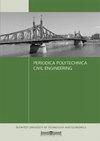Investigation on the Behavior of Bridge Piers Considering Rocking Isolation Constructed on Non-plastic Silts and Sands Using 1g Shaking Table Tests
IF 1.4
4区 工程技术
Q3 ENGINEERING, CIVIL
引用次数: 0
Abstract
Occurred damages on the bridge piers during earthquakes lead to significant financial losses worldwide every year and can cause social problems by disrupting traffic flow and transportation services. Rocking isolation of foundations is one of the damage reduction approaches to avoid structural damage on piers by transferring plastic hinges from piers to underlying soil media. The behavior of rocking foundations on non-plastic silts has not been investigated well until now in the literature. In this research, the characteristic seismic behavior of a bridge pier considering rocking isolation is evaluated using small-scale physical modeling tests. To this aim, eight shaking table tests (with sinusoidal excitations) are conducted where both sandy and silty materials are employed as the soil media. In addition to the effects of the underlying soil, the effects of the critical contact area ratio of the foundation and frequency of input motions are evaluated. Achieved results indicate that the considered bridge pier shows the same behavior trend for underlying silty soil and sandy one. However, because of the frequency-dependent behavior of non-plastic silty soil, the pier attracts lower accelerations and higher moments. Therefore, the achieved results show that the proposed design approaches of rocking foundations that are mostly extracted based on experimental studies on sands (or rarely on clay) can lead to non-conservative designs in silty soils.用1g振动台试验研究非塑性泥沙上考虑隔震的桥墩性能
地震造成的桥墩损坏每年在世界范围内造成巨大的经济损失,并可能通过扰乱交通流量和运输服务造成社会问题。基础隔震是通过将塑性铰从桥墩转移到下垫土介质中来避免桥墩结构损伤的一种减振方法。迄今为止,对非塑性泥沙上的摇摆地基的性能研究还不够充分。在本研究中,采用小尺度物理模型试验评估了考虑隔震的桥梁桥墩的抗震特性。为此,采用砂质和粉质材料作为土介质,进行了8次振动台试验(正弦激励)。除了下垫土的影响外,还评估了基础的临界接触面积比和输入运动频率的影响。研究结果表明,所考虑的桥墩对下卧粉质土和砂质土表现出相同的行为趋势。然而,由于非塑性粉质土的频率依赖性,桥墩受到较低的加速度和较高的弯矩。因此,所取得的结果表明,所提出的基于砂土(或很少基于粘土)试验研究的摇摆基础设计方法可以导致粉质土的非保守设计。
本文章由计算机程序翻译,如有差异,请以英文原文为准。
求助全文
约1分钟内获得全文
求助全文
来源期刊

Periodica Polytechnica-Civil Engineering
工程技术-工程:土木
CiteScore
3.40
自引率
16.70%
发文量
89
审稿时长
12 months
期刊介绍:
Periodica Polytechnica Civil Engineering is a peer reviewed scientific journal published by the Faculty of Civil Engineering of the Budapest University of Technology and Economics. It was founded in 1957. Publication frequency: quarterly.
Periodica Polytechnica Civil Engineering publishes both research and application oriented papers, in the area of civil engineering.
The main scope of the journal is to publish original research articles in the wide field of civil engineering, including geodesy and surveying, construction materials and engineering geology, photogrammetry and geoinformatics, geotechnics, structural engineering, architectural engineering, structural mechanics, highway and railway engineering, hydraulic and water resources engineering, sanitary and environmental engineering, engineering optimisation and history of civil engineering. The journal is abstracted by several international databases, see the main page.
 求助内容:
求助内容: 应助结果提醒方式:
应助结果提醒方式:


